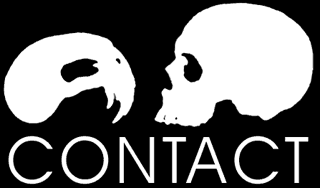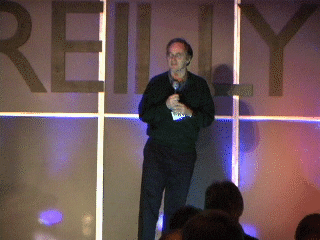Last year’s Contact conference was one of my favorite conferences of all time.
The focus of Contact is really hard to explain, but I’ll try: Space Exploration, Artificial Intelligence, Music, Science Fiction, Film making, Singularity stuff, Robot stuff, Artificial Life, Virtual Worlds, Virtual Reality, Space Colonization, Astrobiology, Astropsychology, Astrosociology, Biotech, Bioinformatics… — and *really* on all of it! (and I’m sure I’m forgetting something) — ALL this stuff is covered — and well!
Just go if you can. Registration is a bargain, and there’s a student rate!
Check out the speaker list.

Category Archives: Biotech
Drilling For Oil Becomes Outdated Technology
Aw come on — we just went through all this trouble to take over Iraq, and now we find out we can make oil out of… anything?
Anything into
Oil Technological savvy could turn 600 million tons of turkey guts and other waste
into 4 billion barrels of light Texas crude each year
By Brad Lemley for Discover Magazine.
In an industrial park in Philadelphia sits a new machine that can change almost anything into oil.
Really.
…Because depolymerization takes apart materials at the molecular level, Appel says, it is “the perfect process for destroying pathogens.” On a wet afternoon in Carthage, he smiles at the new plant
Conjoined Twins Die Soon After Separation Surgery
I was able to capture a “before” clip on NBC news and an “after” clip from the Jim Lehrer News Hour on PBS.
The clips show an interview with the girls and explain the nature of the surgery involved (and what went wrong).
I’ve edited them together into a single news reel:
NBC and PBS On The Conjoined Twins. (Small – 6 MB)


So they died from blood loss — most likely when the makeshift grafted brain arteries didn’t hold. Perhaps they should have waited another couple of years. (When we will be growing arteries whole
Tim O’Reilly At Last Week’s Bioinformatics Conference

Tim O’Reilly Explains Why He’s Excited About Bioinformatics:
Audio Tim O’Reilly On Bioinformatics (MP3 – Hi-Res – 4 MB)
Tim O’Reilly On Bioinformatics (Hi-Res – 73 MB)
Tim O’Reilly On Bioinformatics (Lo-Res – 31 MB)
Tim O’Reilly On Bioinformatics Part 1 of 2 (Lo-Res – 15 MB)
Tim O’Reilly On Bioinformatics Part 2 of 2 (Lo-Res – 16 MB)
Looking Forward To Next Week’s Bioinformatics Conference
I really regretted not going to last year’s O’Reilly Bioinformatics Conference — so when it became time for this year’s conference, I remembered not going to make the same mistake twice.
Jim Kent (who rocked last year’s OSCON will be one of the Keynote’s next week.
I’ll be there Tuesday-Thursday next week and video taping the keynotes and some of the speakers and press conferences.
If you’re interested in learning how to use your computer programming skills to like, save the world and stuff, you might want to check it out.
Oh yeah — these companies are hiring too. They’re always hiring, and growing.
Friendly bunch too
Anyway, I’ll be posting some pre-conference info here after I finish my other back up of projects (like the radio show on crowd control, which I am still working on, but which turned out to be more work than I bargained for editing everything together nicely and providing good information about who’s on the tape, etc.)
A Watchful Look At Adaptive Optics
For Wired News by one of my favorite journalists, Kristen Philipkoski:
Getting a Closer Look at the Eye
Eye diseases such as glaucoma and macular degeneration often aren’t discovered until a patient is well on his way to blindness. But a new imaging technology promises to deliver diagnoses at critically early stages.
The technology, called adaptive optics, was originally developed for peering into outer space. It made headlines most recently for giving astronomers rare views of Saturn’s largest moon, Titan…
In 1953, an astronomer named Horace Babcock first proposed using adaptive optics for looking at stars and planets without atmospheric distortion, but the technology was not developed until the late ’60s and early ’70s by the military and aerospace industry, mainly in conjunction with developing high-powered lasers to destroy satellites. The technology remained classified until 1991.
It wasn’t applied to medical research until about five years ago when David Williams of the University of Rochester noticed that eliminating distortions in the earth’s atmosphere was probably a similar endeavor to eliminating distortions caused by the human eye when trying to use a microscope to see inside it.
Researchers at the University of Heidelberg in Germany had made the same observation, but never succeeded in proving that adaptive optics could work in the eye.
Now, at the Indiana University School of Optometry in Bloomington, Indiana, researchers are utilizing adaptive optics with another technique called optical coherence tomography, which allows doctors to capture images deep inside tissue.
By combining these two powerful technologies, an ophthalmologist might be able to not only find damaged cells in the retina, but also to precisely map the aberrations inside the eye that make eyesight less than perfect.
The new technology would replace the archaic phoropter (the part of the exam when the eye doctor says does it look better here, or here, and you usually can’t tell) and give a theoretically precise diagnosis.
With an exact map of the eye, they could precisely plan laser correction surgery, or create customized contact lenses, Olivier said.
Several combinations of adaptive optics with other imaging technologies are in the works, but the technology is still too expensive and the mirrors too large to enable widespread use.
Brilliant New Technique Temporarily Removes Affected Organ, Nukes It, And Pops It Back In
Out-of-body operation banishes tumours
By Sergio Pistoi for New Scientist.
Instead the surgeons decided to remove the entire liver. The organ was placed in a Teflon bag that neutrons can pass through and taken to a research reactor nearby, where it was irradiated with neutrons. It was then re-implanted, just as in a normal liver transplant operation.
“By explanting the organ, we could give a high and uniform dose to all the liver, which is impossible to obtain inside the body without serious risk to the patient,” says Tazio Pinelli, a physicist who coordinated the work together with liver surgeon Aris Zonta.
“It was a bold stroke and has stirred the interest of many in the field,” says Paul Busse, a neutron radiology expert at Harvard Medical School in Boston.
The technique has been dubbed TAORMINA after the Italian for “advanced treatment of organs by means of neutron irradiation and autotransplant”. But with only one person treated so far, it is too early to judge how safe and effective it is.
Stem Cells May Lead To Diabetes Cure
Here’s the skinny from my one of my favorite journalists, Kristen Philipkoski:
Stem Cells Key to Diabetes Cure.
Dr. Fred Levine, an associate professor of pediatrics at the University of California at San Diego, is doing similar work.
“There’s a lot of ambiguity about what constitutes a stem cell, and it’s becoming less and less clear, rather than more, in this field,” Levine said.
He and his colleagues have succeeded in forcing insulin-secreting beta cells to grow in culture, which causes them to revert to an earlier stage of development.
The problem is, cells like to do one of two things: revert to an earlier stage of development and replicate indefinitely, or differentiate into a specific type of cell.
Artificial Blood Not Quite Here Yet
See the Wired article by Wil McCarthy:
Strange Blood
—Cataclysmic shortages. Tainted supplies. There is a solution: artificial blood..
Foxy Spider
 |
Is it me? Or is this the cutest spider that ever lived smiling for the camera? |
